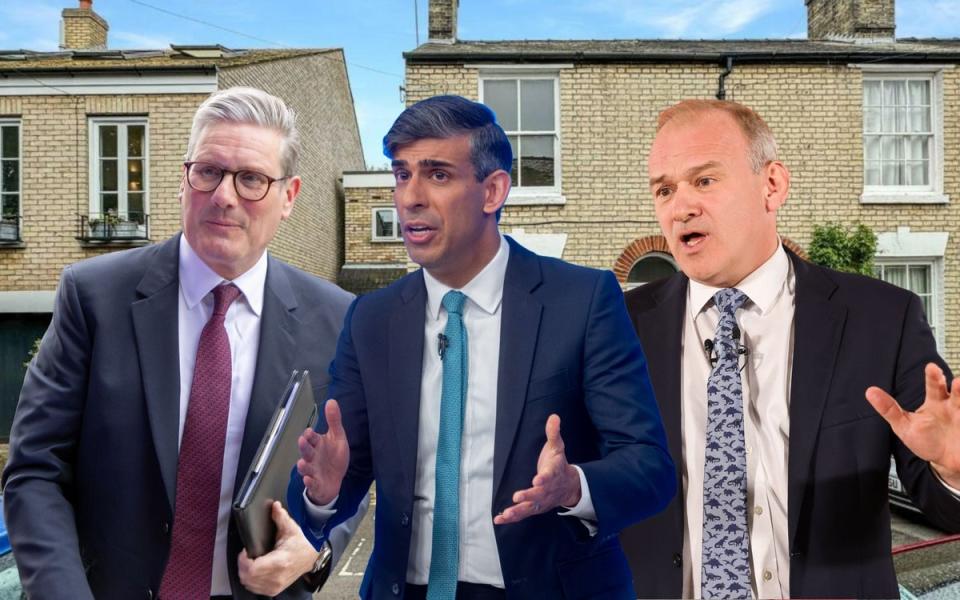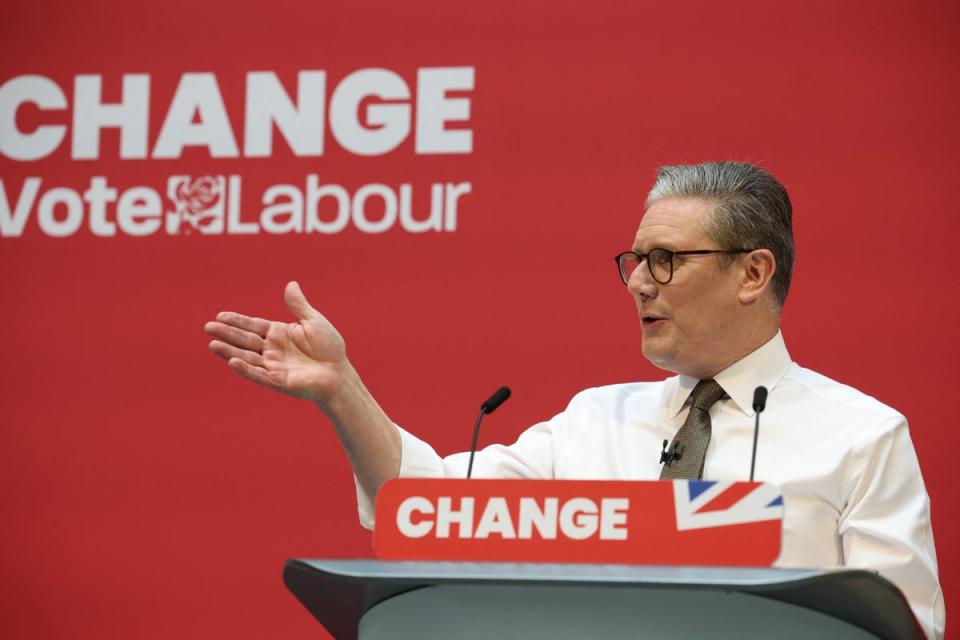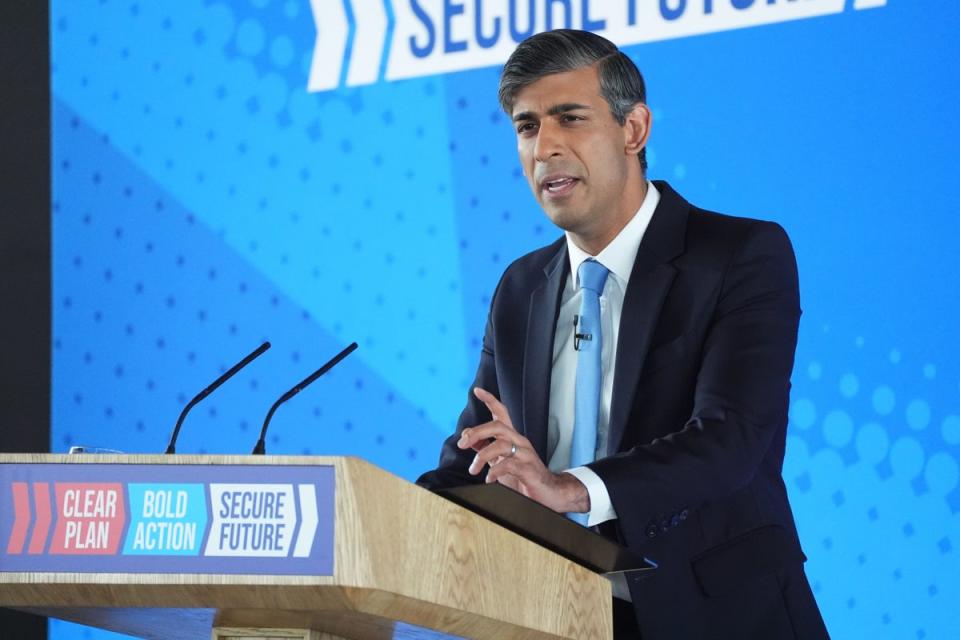General election 2024: How do the party manifestos address the housing crisis?

Given the scale of the UK’s housing crisis, building more homes should be top of the agenda for every party.
The last government promised to build 300,000 new homes a year — a target that was, in a word, missed. In London, the issue is particularly acute.
The aftershocks of Liz Truss’s disastrous minibudget has seen households scramble to find an average of £7,500 year to cover their mortgages, with many Londoners taking in lodgers to make ends meet.
As the cost-of-living crisis rages on, Barclays has warned that one in four Londoners is at risk of missing a mortgage or rent payment.
The average age of a first-time buyer in London is now 38, and the Building Societies Association estimates they would need a deposit of £144,000 and an income of £96,000 to make it onto the property ladder
Renters are suffering as London rents soar ever higher — 11 per cent in the past year according to the Office for National Statistics. No-fault eviction numbers have spiked, and the much-promised ban on section 21 the Renters Reform Bill never made it through Parliament.
Homelessness is still rising, as families are forced to live in London’s shameful temporary accommodation, such as the notorious crime-ridden shipping container estate in Acton.
Seven years on from the Grenfell Tower Fire, thousands of people are stuck in homes with dangerous cladding.
With that in mind, here’s what the UK’s politicians are promising before the country heads to the polls:
Labour manifesto 2024

Mentions of housing: 17
New homes promised: 1.5 million
Party slogan: “Get Britain Building Again”
Targets: Labour would “restore” the current Tory-set housebuilding target of 300,000 new homes a year, with 1.5 million new homes built over the course of the next parliament. Many of these new homes would be delivered in “new towns” as well as “urban extensions”.
London homes: No mention.
First-time buyers: The Labour Manifesto acknowledges that “the dream of homeownership is now out of reach for too many young people”. First-time buyers would be given priority on buying homes in new developments over overseas investors. A mortgage scheme allowing smaller house deposits with “lower mortgage costs” would be implemented, although it doesn’t state if this is the same as the current mortgage scheme or a new one.
Renters: Labour would abolish section 21 no-fault evictions “immediately”. Renters would be given powers to challenge “unreasonable” rent increases. Awaab’s Law, requiring landlords to fix health hazards, would be extended to the private rental sector.
Social housing: Labour promises to “deliver the biggest increase in social and affordable housebuilding in a generation” via: stronger planning rules about numbers of affordable homes in developments; delivering more affordable homes from existing funding; prioritising social rented homebuilding; reviewing the Right to Buy.
Planning: Labour would make planning authorities update their Local Plans, increase the number of planning officers, and prioritise the fast-tracking of brownfield site development. Greenfield belts would be preserved, but green belt areas deemed low quality would be re-designated as grey belt for building on. “Labour will not be afraid to make full use of intervention powers to build the houses we need,” states the manifesto.
Leaseholds: Labour would “bring the feudal leasehold system to an end”, banning new leasehold flats, addressing unfair ground rents and maintenance fees, and enacting right to manage proposals.Cladding: No direct mention, but promises “renewed focus on ensuring those responsible for the building safety crisis pay to put it right”.
Temporary accommodation: No mention.
Homelessness: Pledges to introduce a cross-government strategy to work with mayors and councils to “put Britain back on track to ending homelessness“.
Non-doms: Non-dom tax status would be abolished “once and for all” to replace it with a “modern scheme for people genuinely in the country for a short time”. All those additional planning officers (see above) would be funded by increasing the rate of Stamp Duty Land Tax paid by non-UK.
Conservative manifesto 2024

Mentions of housing: 20
New homes promised: 1.6 million
Party slogan: “Build More Houses in the Right Places”
Targets: Delivering 1.6 million homes over the next Parliament, including 100,000 homes via abolishing EU nutrient neutrality rules (whereby developers must demonstrate they won’t add any more phosphates or nitrates to the water supply).
London homes: The Conservatives pledge to “raise density levels” of inner London to match Paris and Barcelona, and deliver more family homes via “forcing the Mayor to plan for more homes on brownfield sites”. Euston, Old Oak Common and Thamesmead would be earmarked for regeneration schemes. First-time buyers: “We will also take immediate steps to support more people onto the housing ladder” states the Conservative manifesto. The Stamp duty threshold for first-time buyers would be set at £425,000. A “new and improved” Help to Buy scheme would be introduced offering a 20 per cent equity loan to boost a five per cent deposit on “interest terms they can afford”. The 95 per cent loan-to-value mortgage guarantee scheme would be continued.
Renters: The Conservative’s promise to finish the job with the Renters Reform Bill and abolish no-fault eviction, after reforming the courts to ensure landlord’s can still evict tenants “guilty” of anti-social behaviour.
Social housing: The Affordable Homes Programme would be renewed for developers, with a focus on regenerating existing housing estates.
Planning: The Conservatives would fast-track planning for housing on brownfield sites. Design codes would favour “new family homes and mansion-blocks on tree-lined streets built in the local character”. Greenbelt protections would remain in place. Councils would be given more powers over holiday lets “hollowing out communities”. Leaseholds: Under another Conservative government they would cap ground rent at £250 and reduce it to peppercorn rates over time. The manifesto also promises to “end the misuse of forfeiture” and make it easier to establish commonhold.
Cladding: The manifesto pledges continued support for leaseholders with cladding replacement bills.
Temporary accommodation: The Conservatives would “review the quality of temporary accommodation”.
Homelessness: Another Tory government would “continue” work to “end rough sleeping” and preventing “people from ending up on the streets in the first place”.
Non-doms: No mention.
Liberal Democrat manifesto 2024

Mentions of housing: 17
New homes promised: 380,00 a year
Party slogan: “A Home is a Necessity”
Targets: The Lib Dem manifesto says the housing market is “in crisis after years of Conservative neglect”. Their target of 380,000 new homes a year would include 150,000 social homes, delivered via ten “new garden cities” and community-led development in existing cities and towns.
London homes: No mention.First-time buyers: No mention.
Renters: The Lib Dem manifesto also promises “a fair deal for renters”, with an immediate ban on no-fault eviction. Three-year tenancies would become the new default. The manifesto also pledges to create a national register of licensed landlords. Social renters would be given enforced standards for their homes, including a “strict” time limit on repairs. Tenant panels would be recognised as part of landlord governance.
Social housing: Along with the 150,000 new social homes a year, the manifesto promises to give local authorities the power to end Right to Buy. Social and affordable housing would be included in brownfield development incentives. A Rent to Own model for social housing would allow social tenants to gain an increasing stake in their rental home, owning it outright after 30 years.
Planning: The Liberal Democrats say they would expand Neighbourhood Planning (whereby communities allocate land for development) across England, and allow councis to buy land at current value rather than hope-value baisis. Local planning departments would be “properly fund[ed]”. Building on flood zones would be prevented by allowing local entories to “set their own fees”. Brownfield development would be encourages. Developers who “refuse to build” would face “use-it-or-lose-it” planning permission. Delivery of infrastructure, services and amenities would be included in the planning process.
Leaseholds: Would be abolished under the Lib Dems, and ground rents capped to “a nominal fee”.
Cladding: The Lib Dems outright promise to “remove dangerous cladding from all buildings, while ensuring that leaseholders do not have to pay a penny towards it”.
Temporary accommodation: The manifesto say that building more homes would “relieve the soaring demand” for temporary accommodation.
Homelessness: Under the Liberal Democrats, rough sleeping would be ended by within the nest Parliament. The manifesto also promises to scrap the “archaic” Vagrancy Act, which makes sleeping rough a criminal offence. The manifesto pledges to “urgently publish” a plan to end homelessness and introduce a “somewhere safe to stay” legal duty to ensure those at risk of rough sleeping have access to emergency accommodation and a needs assessment. Local authorities would receive “sufficient financial resources” to provide accomodation for domestic abuse survivors.
Non-doms: No mention.

 Yahoo Finance
Yahoo Finance 